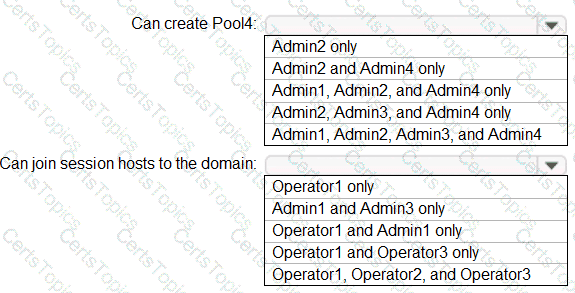You have an Azure Virtual Desktop deployment that contains the resources shown in the following table.

You need to enable just-in-time (JIT) VM access for all the session hosts.
What should you do first?
You have an Azure Virtual Desktop host pool that runs Windows 10 Enterprise multi-session. User sessions are load-balanced between the session hosts. Idle session timeout is 30 minutes. You plan to shut down a session host named Host1 to perform routine maintenance. You need to prevent new user sessions to Host1 without disconnecting active user sessions.
Solution: From the Azure portal, add lock on Host1. Does this meet the goal?
You have a shared image gallery that contains the Windows 10 images shown in the following table.

You create a Windows Virtual Desktop deployment that has the following settings:
Host pool name: Pool1
Location: West US
Host pool type: Personal
Which images can you use for the session hosts?
Note: This question is part of a series of questions that present the same scenario. Each question in the series contains a unique solution that might meet the stated goals. Some question sets might have more than one correct solution, while others might not have a correct solution.
After you answer a question in this section, you will NOT be able to return to it. As a result, these questions will not appear in the review screen.
You have a Windows Virtual Desktop host pool named Pool1 that is integrated with an Azure Active Directory Domain Services (Azure AD DS) managed domain.
You need to configure idle session timeout settings for users that connect to the session hosts in Pool1.
Solution: From an Azure AD DS-joined computer, you modify the AADDC Computers GPO settings.
Does that meet the goal?
You have an Azure subscription named Sub1 and a Microsoft 365 E5 subscription.
The tenant contains user accounts for all internal users and users from a partner company named Fabrikam, Inc. Each internal user is assigned a Microsoft 365 E5 license. The users at Fabrikam are not assigned any licenses.
Sub1 has an Azure Virtual Desktop deployment that contains a host pool named Pool1. Pool1 contains a RemoteApp named Appl.
You need to configure access to App1. The solution must meet the following requirements:
• The Fabrikam users must be licensed by using Per-user access pricing.
• App1 must be accessible to all the internal and Fabrikam users.
• Costs must be minimized.
What should you do first?
You have an Azure subscription.
You need to deploy an Azure Virtual Desktop host pool that will contain 20 Windows 11 session hosts. The solution must meet the following requirements:
• Each session host must have a Windows client license applied.
• Administrative effort must be minimized.
What should you use to deploy the session hosts?
You have a Azure Virtual Desktop deployment that contains multiple host pools.
You need to create a PowerShell script to sign users out of a specific session host before you perform a maintenance task.
Which PowerShell module should you load in the script?
You have an Azure Virtual Desktop deployment that contains the resources shown in the following table.

You plan to enable Start VM on connect for Pool1.
You create a custom Azure role named Role1 that has sufficient permissions to start virtual machines on demand.
You need to ensure that the session hosts in Pool1 can start on demand.
To which service principal should you assign Role1?
You have an Azure subscription that contains a virtual network named VNet1. a storage account named storage1, and five Azure Virtual Desktop session hosts. VNet1 and storage1 ate in the East US Azure region. The session hosts are connected to VNet1.
In storage1. you create an Azure File share named share1.
You need to ensure that the session hosts connect to share1 by using the Microsoft backbone network.
Solution: You configure network peering for VNet1.
Does this meet the goal?
You plan to deploy Azure Virtual Desktop.
You are deploying Storage Spaces Direct to a cluster that will store FSLogix profile containers. The cluster will NOT use Cloud witness.
What is the minimum number of virtual machines required for the cluster?
You have an Azure Virtual Desktop session host named Host1.
You need to check the status of Microsoft Defender Antivirus on Host1.
Which PowerShell cmdlet should you run?
You have an Azure Virtual Desktop deployment that contains the resources shown in the following table.

You create the resources shown in the following table.

You need to meet following requirements:
• Back up the FSLogix profile containers used by HostPool1.
• Backup the data disks in HostPool2.
To which resources can you back up the profile containers and the data disks? To answer, select the appropriate options in the answer area.
NOTE: Each correct selection is worth one point.
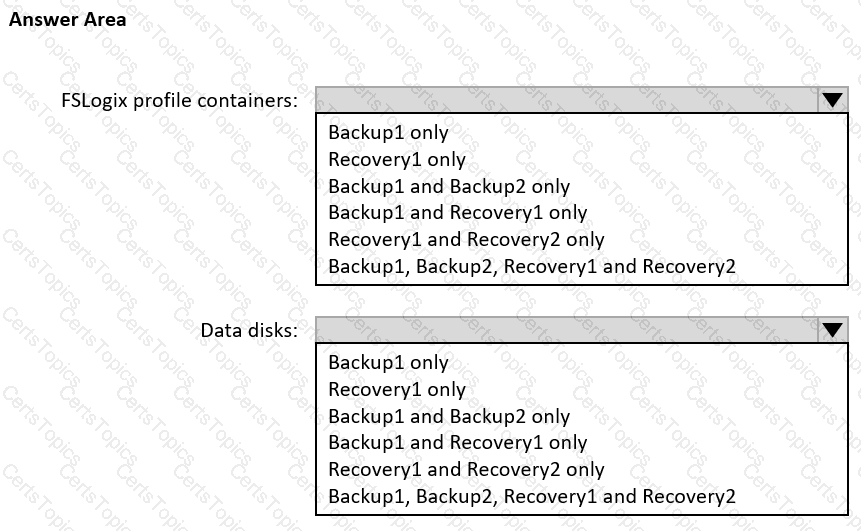
You have an Azure Virtual Desktop deployment and the Azure Storage accounts shown in the following table.

You plan to create FSLogix profile containers and store the containers in the storage accounts.
You need to identify which storage accounts support the FSlogix profile containers, and then order the accounts from highest to lowest redundancy.
Which three storage accounts should you identify in sequence? To answer, move the appropriate accounts from the list of accounts to the answer area and arrange them in the correct order.

Your network contains an on-premises Active Directory domain and a Windows Virtual Desktop deployment.
The computer accounts for all the session hosts are in an organizational unit (OU) named WVDHostsOU. All user accounts are in an OU named CorpUsers.
A domain administrator creates a Group Policy Object (GPO) named Policy1 that only contains user settings.
The administrator links Policy1 to WVDHostsOU.
You discover that when users sign in to the session hosts, none of the settings from Policy1 are applied.
What should you configure to apply GPO settings to the users when they sign in to the session hosts?
You have an Azure Virtual Desktop host pool named Pool1 and an Azure Storage account named storage1. Pool1 and storage1 are in the same Azure region.
The current network utilization of the session hosts during peak hours is 95%.
You plan to use FSLogix profile containers stored in storage1 for users that connect to Pool1.
You need to configure the session hosts and storage1 to minimize network latency when loading and updating profiles.
What should you do? To answer, select the appropriate options in the answer area.
NOTE: Each correct selection is worth one point.

You have a Azure Virtual Desktop deployment.
You Implement FSLogix profile container.
You need to ensure that the FSlogix profile containers are not used for specific users.
What should you do?
You have an Azure subscription that contains two users named User1 and User2 and the Microsoft Entra groups shown in the following table.

You have an Azure Virtual Desktop host pool named Pool! that contains two session hosts named Host1 and Host2. The session hosts use FSLogix user profiles.
Host1 contains the local groups shown in the following table.

Host2 contains the local groups shown in the following table.

User1 connects to Pool1 and modifies his desktop.
User1 reports that when he reconnects to Pool1, the desktop modifications fail to appear.
You need to ensure that User1 sees the modified desktop when he connects to Pool1. The solution must minimize the impact on other user profiles.
What should you do?
You network contains an on-premises Active Directory domain. The domain contains a universal security group named WVDusers.
You have a hybrid Azure Active Directory (Azure AD) tenant. WVDusers syncs to Azure AD.
You have a Windows Virtual Desktop host pool that contains four Windows 10 Enterprise multi-session hosts.
You need to ensure that only the members of WVDusers can establish Windows Virtual Desktop sessions to the host pool.
What should you do?
Your company has a main office and two branch offices. Each office connects directly to the internet. The router in each branch office is configured as an endpoint for the following VPNs:
A VPN connection to the main office
A site-to-site VPN to Azure
The routers in each branch office have the Quality of Service (QoS) rules shown in the following table.

Users in the branch office report slow responses and connection errors when they attempt to connect to Windows Virtual Desktop resources.
You need to modify the QoS rules on the branch office routers to improve Windows Virtual Desktop performance.
For which rule should you increase the bandwidth allocation?
You have an Azure Virtual Desktop deployment that contains the resources shown in the following table.
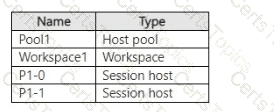
You need to ensure that users can connect to a session host in the deallocated state. On which resources can you enable Start VM on Connect?
You have an Azure Virtual Desktop deployment.
You plan to create the host pools shown in the following table.

You plan to provide external users with access to the session hosts.
You need to ensure that connections to Azure Virtual Desktop are licensed by using per-user access pricing.
To which host pools will per-user access pricing apply?
You need to recommend an authentication solution that meets the performance requirements.
Which two actions should you include in the recommendation? Each correct answer presents part of the solution.
NOTE: Each correct selection is worth one point.
You need to configure a conditional access policy to meet the authentication requirements.
What should you include in the policy configuration? To answer, select the appropriate options in the answer area.
NOTE Each correct selection is worth one point.

You need to modify the custom virtual machine images to meet the deployment requirements.
What should you install?
Which two roles should you assign to Admin2 to meet the security requirements? Each correct answer presents part of the solution.
NOTE: Each correct selection is worth one point.
You need to configure the user settings of Admin1 to meet the user profile requirements.
What should you do?
You need to implement network security to meet the security requirements and the performance requirements.
Which two actions should you perform? Each correct answer presents a complete solution.
NOTE: Each correct selection is worth one point.
You need to ensure the resiliency of the user profiles for the Boston office users. The solution must meet the user performance requirements.
What should you do?
You need to recommend a DNS infrastructure that meet the performance requirements. What should you recommend? To answer, select the appropriate options in the answer area. NOTE: Each correct selection is worth one point.

You need to deploy the session hosts to meet the deployment requirements Which PowerShell cmdlel should you run first?
You need to ensure that you can implement user profile shares for the Boston office users. The solution must meet the user profile requirements.
Which four actions should you perform in sequence? To answer, move the appropriate actions from the list of actions to the answer area and arrange them in the correct order.

Which monitoring solution should you configure to meet the security requirements?
What should you do to ensure that the session hosts meet the application requirements for App1?
You need to create a Conditional Access policy to meet the security require-ments.
How should you configure the policy? To answer, select the appropriate options in the answer area.
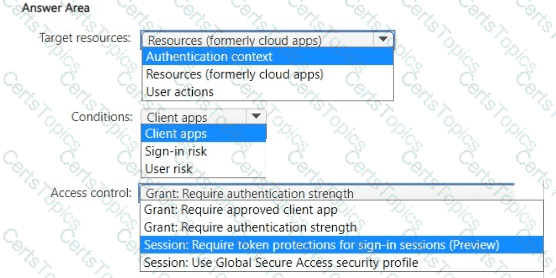
Which type of host pool and load balancing algorithm should you configure to meet the performance requirements? To answer, select the appropriate options in The answer area.
NOTE: Each correct selection is worth one point.
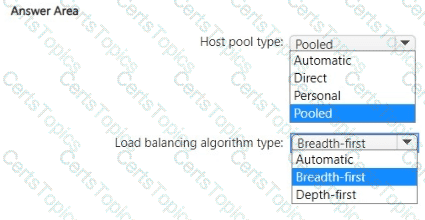
Which host pool design and which service should you configure to meet the disaster recovery requirements? To answer, drag the appropriate solution to the correct requirements. Each solution may be used once, more than once, or not at all. You may need to drag the split bar between panes or scroll to view content
NOTE: Each correct selection is worth one point.
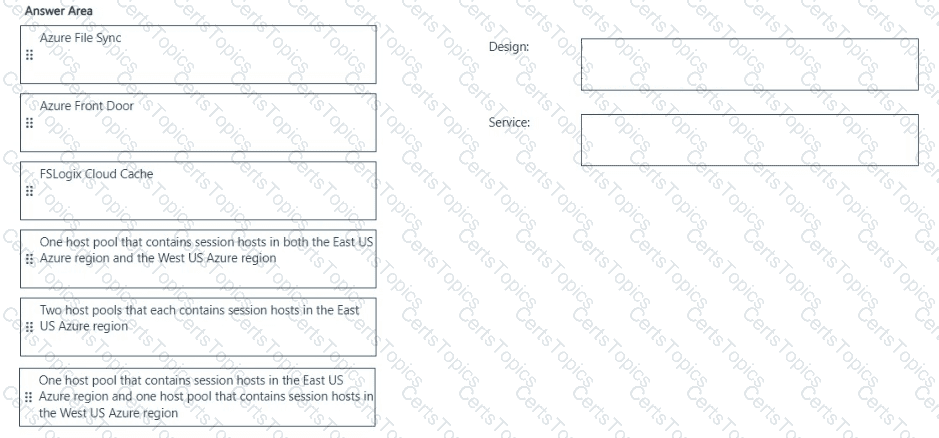
What should you do to meet the user profile requirements?
Which settings should you configure to meet the performance requirements?
Which two actions should you perform to meet the security requirements for Defender for Endpoint? Each correct answer presents a complete solution.
NOTE: Each correct selection is worth one point.
What should you do to meet the application requirements? To answer, select the appropriate options in the answer area.
NOTE: Each correct selection is worth one point.

What should you configure to meet the networking requirements?
You need to prepare the disk on VM1 for use with the Azure Virtual Desktop deployment. Which two actions should you perform? Each correct answer presents part of the solution. NOTE: Each correct selection is worth one point.
You need to configure the device redirection settings. The solution must meet the technical requirements.
Where should you configure the settings?
Which setting should you modify for VNET4 before you can deploy Pool4?
You plan to implement the FSLogix profile containers for the Seattle office.
Which storage account should you use?
You are planning the deployment of Pool4.
What will be the maximum number of users that can connect to Pool4, and how many session hosts are needed to support five concurrent user sessions? To answer, select the appropriate options in the answer area.
NOTE: Each correct selection is worth one point.
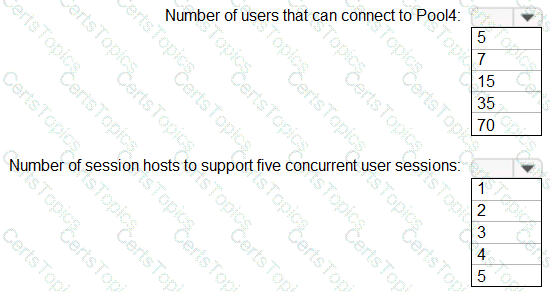
You need to evaluate the RDS deployment in the Seattle office. The solution must meet the technical requirements.
Which three actions should you perform in sequence? To answer, move the appropriate actions from the list of actions to the answer area and arrange them in the correct order.
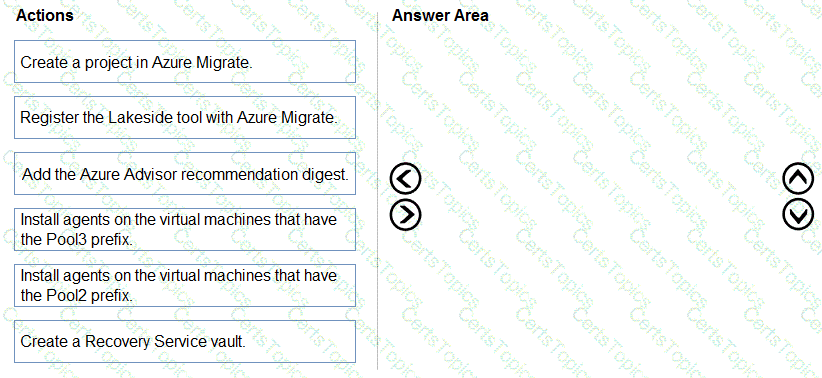
Which role should you assign to Operator2 to meet the technical requirements?
You need to configure the virtual machines that have the Pool1 prefix. The solution must meet the technical requirements.
What should you use?
Which three PowerShell modules should you install on Server1 to meet the technical requirements? Each correct answer presents part of the solution.
NOTE: Each correct selection is worth one point.
Which users can create Pool4, and which users can join session hosts to the domain? To answer, select the appropriate options in the answer area.
NOTE: Each correct selection is worth one point.
